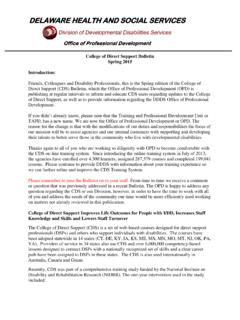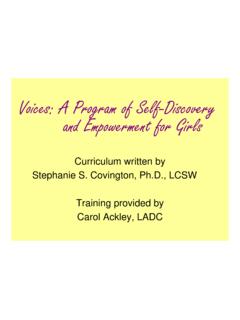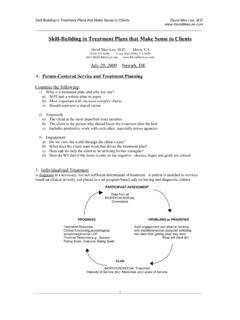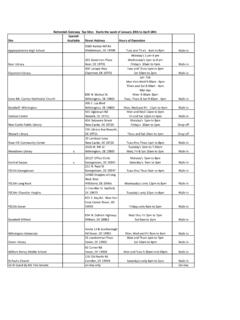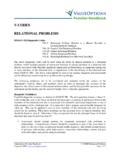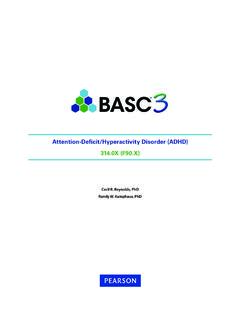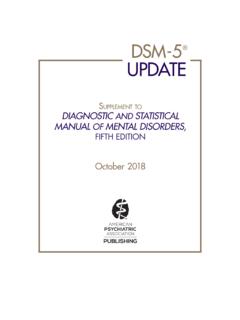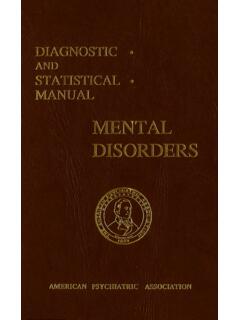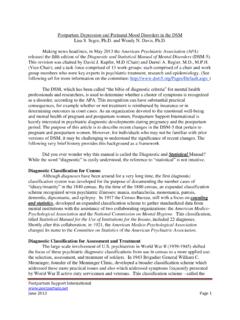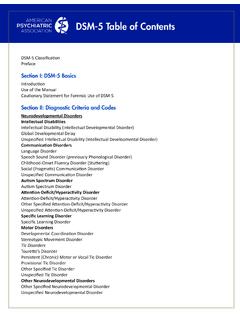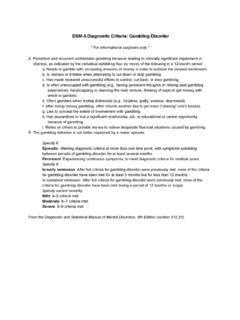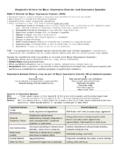Transcription of The Diagnostic and Statistical Manual of Mental Disorders ...
1 The Diagnostic and Statistical Manual of Mental Disorders , Fifth Edition (DSM-5) Cardwell C. Nuckols, PhD HISTORY OF THE DSM 1840 1 Dx Census Idiocy/Insanity Also in the 1840s, southern alienists discovered a malady called Drapetomania - the inexplicable, mad longing of a slave for freedom. 1880 7 Dx s Census Mania mostly as defined today, a condition characterized by severely elevated mood. Melancholia would be noted as depression today. Monomania - Pathological obsession with a single subject or idea. Excessive concentration of interest upon one particular subject or idea. The difference between monomania and passion can be very subtle and difficult to recognize. Paresis general or partial paralysis.
2 (This would not be the last time that a physical affliction crept into the psychological arena; among the Disorders described in the DSM-IV TR is snoring, or Breathing Related Sleep Disorder , pp. 615-622). Dementia as described today as characterized by multiple cognitive deficits that include impairment in memory (most common Alzheimer's). Dipsomania - An insatiable craving for alcoholic beverages. Epilepsy HISTORY OF THE DSM 1940 26 Dx's (ICD-6; WHO) Which took its nomenclature from the US Army and Veterans Administration nomenclature. The WHO system included 10 categories for psychoses, 9 for psychoneuroses, and 7 for Disorders of character, behavior, and intelligence) 1952 DSM 106 Dx s DSM-I included 3 categories of psychopathology: organic brain syndromes, functional Disorders , and Mental deficiency.
3 These categories contained 106 diagnoses. Only one diagnosis, Adjustment Reaction of Childhood/Adolescence, could be applied to children. 1968 DSM-II 185 Dx s (revised DSM-II, 1974) It had 11 major Diagnostic categories. Increased attention was given to the problems of children and adolescence with the categorical addition of Behavior Disorders of Childhood-Adolescence. This category included Hyperkinetic Reaction, Withdrawing Reaction, Overanxious Reaction, Runaway Reaction, Unsocialized Aggressive Reaction, and Group Delinquent Reaction. HISTORY OF THE DSM Up until December 26, 1974 Homosexuality was considered a form of deviant behavior and was a psychiatric condition. HISTORY OF THE DSM 1980 DSM-III 265 Dx s (roughly coincided with ICD-9, but differed from the ICD-9 which still listed Disorders for Statistical reasons as opposed to clinical utility).
4 DSM-III included multiaxial system. Explicit Diagnostic criteria. Descriptive approach neutral to etiology theory. Unlike its predecessors, DSM-III, it was based on scientific evidence. Its reliability was improved with the addition of explicit Diagnostic criteria and structured interviews. Although ICD and DSM were similar in terms of criteria, their codes were very different. 1987 DSM-III-R 297 Dx s Occurred because DSM-III revealed a number of inconsistencies in the system and a number of instances in which the criteria were not entirely clear. 1994 DSM-IV 365 Dx s DSM-III nomenclature allowed more precise research of Disorders for the DSM-IV and DSM-IV -TR. 2000 DSM-IV-TR 365 Dx s HISTORY OF THE DSM DSM-5 SECTION I-BASICS Includes organizational structure SECTION II- Diagnostic CRITERIA AND CODES SECTION III-EMERGING MEASURES AND MODELS Alternative Model for Personality Disorders Conditions for Further Study APPENDIX DSM-5 SECTION I-BASICS.
5 The boundaries between many disorder categories are more fluid over the life course than DSM-IV recognized, and many symptoms assigned to a single disorder may occur, at varying levels of severity, in many other Disorders . Scientific evidence places many, if not most, Disorders on a spectrum with closely related Disorders that have shared symptoms DSM-5 SECTION I-BASICS Organizational Structure DSM is a medical classification of Disorders and as such serves as a historically determined cognitive schema imposed on clinical and scientific information to increase its comprehensibility and utility. Conditions for Further Study, described in Section III, are those for which it was determined that the scientific evidence is not yet available to support clinical use.
6 DSM-5 SECTION I-BASICS Organizational Structure Personality Disorders are included in both Sections II and III. Section II represents an update of the text associated with the same criteria found in DSM-IV-TR, whereas Section III includes the proposed research model for personality disorder diagnosis and conceptualization DSM-5 SECTION I-BASICS Organizational Structure Harmonization with ICD-11 ( International Classification of Disease) DSM-5 and proposed structure of ICD-11 are working toward consistency ICD-10 is scheduled for US implementation in October 2014 ICD-9 codes are used in DSM-5 Dimensional Approach to Diagnosis Previous DSM s considered each diagnosis categorically separate from health and other diagnoses Doesn t capture the widespread sharing of symptoms and risk factors (why we had some many NOS diagnoses)
7 Dimensional Approach to Diagnosis Shared neural substrates Family traits Genetic risk factors Specific environmental risk factors Biomarkers Temperamental antecedents Abnormalities of emotional or cognitive processing Symptom similarity Course of illness High comorbidity Shared treatment response Dimensional Approach to Diagnosis It is demonstrated that the clustering of Disorders according to internalizing and externalizing factors represent an empirically supported framework. Within both the internalizing group (anxiety, depression and somatic) and externalizing group (impulsive, disruptive conduct and substance use), the sharing of genetic and environmental risk factors likely explains the comorbidities DSM-5 SECTION I-BASICS Organizational Structure Developmental and Lifespan Considerations Begins with diagnoses that occur early in life (neurodevelopmental and schizophrenia spectrum), followed by diagnoses that more commonly manifest in adolescence and young adulthood (bipolar, depressive and anxiety Disorders and ends with diagnoses relevant to adulthood and later life (neurocognitive Disorders ))
8 After neurodevelopmental Disorders , see groups of internalizing (emotional and somatic) Disorders , externalizing Disorders , neurocognitive Disorders and other Disorders DSM-5 SECTION I-BASICS Organizational Structure Developmental and Lifespan Considerations Cultural Issues Gender Differences Use of Other Specified and Unspecified Disorders Replaces NOS designation Other Specified used when clinician wishes to communicate the specific reason the presentation does not meet criteria for diagnoses If clinician does not choose to specify the reason Unspecified Disorder is used DSM-5 SECTION I-BASICS Organizational Structure The Multiaxial System DSM-5 has moved to a nonaxial documentation system DSM-5 has combined Axis III with Axes I and II.
9 Clinicians should continue to list medical conditions that are important to the understanding or management of an individual's Mental disorder Axis IV psychosocial and environmental problems utilize a selected set of ICD-9-CM V codes and the new Z codes contained in ICD-10 Axis V GAF is dropped but a global measure of disability the WHO Disability Assessment Schedule (WHODAS) is included in Section III DSM-5 SECTION I-BASICS Provisional Diagnosis When strong presumption that full criteria will ultimately be met Examples When a extremely depressed individual is unable to give an adequate history When differential diagnosis depends exclusively on duration of illness such as schizophreniform disorder where duration is over one month but less than six DSM-5 SECTION I-BASICS Coding and Reporting Identifying Diagnostic and Statistical codes established by WHO, the US Centers for Medicare and Medicaid Services (CMS), the Centers for Disease Control and Prevention Example Opioid Withdrawal ( )
10 Is ICD-9-CM is ICD-10-CM code for adoption in October 2014 DSM V SECTION II- Diagnostic CRITERIA AND CODES Neurodevelopmental Disorders Schizophrenia Spectrum and Other Psychotic Disorders Bipolar and Related Disorders Depressive Disorders Anxiety Disorders Obsessive-Compulsive and Related Disorders DSM V SECTION II- Diagnostic CRITERIA AND CODES Trauma- and Stressor-Related Disorders Dissociative Disorders Somatic Symptom and Related Disorders Feeding and Eating Disorders Elimination Disorders Sleep-Wake Disorders Sexual Dysfunctions DSM V SECTION II- Diagnostic CRITERIA AND CODES Gender Dysphoria Disruptive, Impulse-Control, and Conduct Disorders Substance-Related and Addictive Disorders Neurocognitive Disorders Personality Disorders DSM V SECTION II- Diagnostic CRITERIA AND CODES Paraphilic Disorders Other Mental Disorders Medication-Induced Movement Disorders and Other Adverse Effects of Medication Other Conditions That May Be a Focus of Clinical Attention NEURODEVELOPMENTAL Disorders INTELLECTUAL DISABILITIES COMMUNICATION Disorders AUTISM SPECTRUM DISORDER ATTENTION-DEFICIT/HYPERACTIVITY DISORDER SPECIFIC LEARNING DISORDER MOTOR Disorders TIC Disorders SUCH AS TOURETTES Using DSM-I V, patients could be diagnosed with four separate Disorders .


